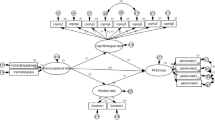Abstract
This study was conducted to develop a comprehensive Multidimensional Locus of Pain Control questionnaire (MLPC) and to examine how locus of pain control is related to pain appraisals, pain coping strategies, and adjustment to chronic pain. Subjects were 170 chronic headache patients. By means of factor analysis, four subscales were derived: an Internal, a Chance, a Physician, and a Medication locus of pain control orientation scale. The reliability and validity of the subscales appeared to be satisfactory. The results of the present study indicate that the locus of pain control orientation is significantly related to pain appraisals such as perceived pain control and catastrophizing and, to a lesser degree, to coping strategies as measured by the Coping Strategies Questionnaire (CSQ). However, almost no relationship was observed between locus of pain control and adjustment to pain. Further research with the MLPC in different chronic pain populations is warranted in order to investigate whether the results found in this study can be generalized to chronic pain patients in general.
Similar content being viewed by others
References
Arrindell, W. A., & Ettema, H. (1987).SCL-90; Handleiding bij een multidimensionele psychopathologie-indicator. Lisse: Swets & Zeitlinger B.V.
Blanchard, E. B., Andrasik, F., Arena, J., Neff, D. F., Jurish, E., Teders, S. J., Saunders, N. L., Pallmeyer, T. P., Dudek, B. C., & Rodichok, L. D. (1984). A bio-psycho-social investigation of headache activity in a chronic headache population.Headache, 24, 79–87.
Buckelew, S. P., Shutty, M. S., Hewett, J., Landon, T., Morrow, K., & Frank, R. G. (1990). Health locus of control, gender differences and adjustment to persistent pain.Pain, 42, 287–294.
Cattell, R. B. (1966). The scree test for the number of factors.Multivariate Behavioral Research, 1, 245–276.
Cohen, J. (1977).Statistical power analysis for behavioural sciences, rev. ed. New York: Academic Press.
Cohen, J., & Cohen, P. (1975).Applied multiple regression/correlation analysis for the behavioral sciences. New York: Erlbaum.
Crisson, J. E., & Keefe, F. J. (1988). The relationship of locus of control to pain coping strategies and psychological distress in chronic pain patients.Pain, 35, 147–154.
Derogatis, L. R., & Cleary, P. A. (1977). Factorial invariance across gender for the primary symptom dimension of the SCL-90.British Journal of Social and Clinical Psychology, 16, 347–356.
Engstrom, D. (1983). Cognitive behavioral therapy methods in chronic pain treatment. In J. J. Bonica et al. (Eds.),Advances in pain research and therapy, 5 (pp. 829–838). New York: Raven Press.
Holroyd, K. A., Nash, J. M., Pingel, J. D., Cordingley, G. E., & Jerome, A. (1991). A comparison of pharmacological (Amitriptyline HCL) and nonpharmacological (cognitive-behavioral) therapies for chronic tension headaches.Journal of Consulting and Clinical Psychology, 59, 387–393.
Jensen, P. M., Turner, J. A., Romano, J. M., & Karoly, P. (1991). Review article, coping with chronic pain: A critical review of the literature.Pain, 47, 249–283.
Lazarus, R. A., & Folkman, S. (1984).Stress, appraisal, and coping. New York, Springer.
Levenson, H. (1973). Multidimensional locus of control in psychiatric patients.Journal of Consulting and Clinical Psychology, 41, 397–404.
Levenson, H. (1974). Activism and powerful others: Distinctions within the concept of internal-external control.Journal of Personality Assessment, 38, 377–383.
Levenson, H. (1981). Differentiating among internality, powerful others, and chance. In H. M. Lefcourt (Eds.),Research with locus of control construct, 1 (pp. 15–63). New York: Academic Press.
Linssen, A. C. G. (1990).Pijnbeheersing, Een cursus voor mensen met rugpijn (Pain control. A course for people with low-back pain), Unpublished doctoral dissertation, Leiden, The Netherlands: Leiden University.
Martin, N. J., Holroyd, K. A., & Penzien, D. B. (1990). The headache-specific locus of control scale: Adaption to recurrent headaches.Headache, 30, 729–734.
Nunnaly, J. C. (1967).Psychometric theory. New York: McGraw-Hill.
Rosenstiel, A. K., & Keefe, F. J. (1983). The use of coping strategies in chronic low back pain patients: Relationship to patient characteristics and current adjustment.Pain, 17, 33–44.
Rotter, J. B., Seeman, M., & Liverant, S. (1962). Internal versus external control of reinforcements: A major variable in behavior theory.Decisions, Values and Groups, 2, 473–516.
Rotter, J. B. (1966). Generalized expectations for internal versus external control of reinforcements.Psychological Monographs, 80, 1–27.
Seligman, M. E. P. (1975).Helplessness, on depression, development and death. San Francisco: W. H. Freeman.
Skevington, S. M. (1983). Chronic pain and depression: Universal or personal helplessness?Pain, 15, 309–317.
Skevington, S. M. (1990). A standardized scale to measure beliefs about controlling pain (BPCQ): A preliminary study.Psychology and Health, 4, 221–232.
Spinhoven, Ph., ter Kuile, M. M., Linssen, A. C. G., & Gazendam, B. (1989). Pain coping strategies in a Dutch population of chronic low back pain patients.Pain, 37, 77–83.
Stevens, J. (1986).Applied multivariate statistics for the social sciences. Hillsdale, NJ: Erlbaum Associates.
ter Kuile, M. M., Spinhoven, Ph., & Linssen, A. C. G. (1992).Autogenic training and cognitive-self hypnosis in the treatment of recurrent headaches in three different subjects groups. Paper presented at the 22nd European Congress on Behavior Therapy, Coimbra, Portugal, Sept. (submitted for publication).
Toomey, T. C., Mann, J. D., Abashian, S., & Thompson-Pope, S. (1991). Relationship between perceived self-control of pain, pain description and functioning.Pain, 45, 129–133.
Wallston, B. S., Wallston, K. A., Kaplan, G. D., & Maides, S. A. (1976). Development and validation of the health locus of control scale.Journal of Consulting and Clinical Psychology, 44, 580–585.
Wallston, K. A., Wallston, B. S., & De Vellis, R. (1978). Development of the multidimensional health locus of control (MHLC) scales.Health Education Monographs, 6, 160–169.
Author information
Authors and Affiliations
Rights and permissions
About this article
Cite this article
ter Kuile, M.M., Linssen, A.C.G. & Spinhoven, P. The development of the multidimensional locus of pain control questionnaire (MLPC): Factor structure, reliability, and validity. J Psychopathol Behav Assess 15, 387–404 (1993). https://doi.org/10.1007/BF00965040
Accepted:
Issue Date:
DOI: https://doi.org/10.1007/BF00965040




